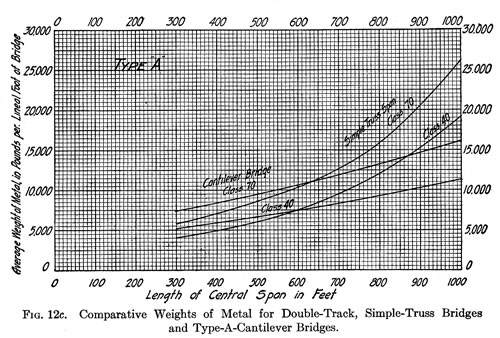| ECONOMICS OF SIMPLE-TRUSS AND CANTILEVER BRIDGES | 87 |
|
bridges. It will be noted that the span-length for equal weights is about 620 feet. If the central span must be erected by cantilevering, extra metal will be required for the simple-truss layout, amounting to about 8 per cent of the truss-weight. The span-length for equal weights will then be a little over 500 feet. If the side-spans in the simple-truss layout be replaced by steel trestle, the span length for equality of weights will be about 700 feet when the central span is erected on falsework. This layout, evidently, cannot be used when the central span must be cantilevered out. The Type-A cantilever of the proportions shown in Fig. 12a is usually an uneconomic layout to adopt when the distance between the end piers is a
fixed quantity, while the two intermediate piers can be placed where desired. For such a location there should generally be used three simple-truss spans, a Type-C cantilever, or a cantilever with the end spans nearly as long as the central span. As before stated, this latter layout is discussed subsequently in this chapter. In many cases, however, the piers of the Type-A cantilever with a long central span will be much cheaper than those of the simple-span bridge, on account of their being nearer to the banks of the river. For such a crossing, the total cost of the simple-span structure can sometimes be reduced by lengthening the center span and shortening the side-spans; and the most economic layout for the simple-span bridge should first be found, and its total cost then compared with that of the cantilever structure. There is an economic consideration of some importance in the comparison of simple-truss and cantilever bridges which, as far as the author knows, |
